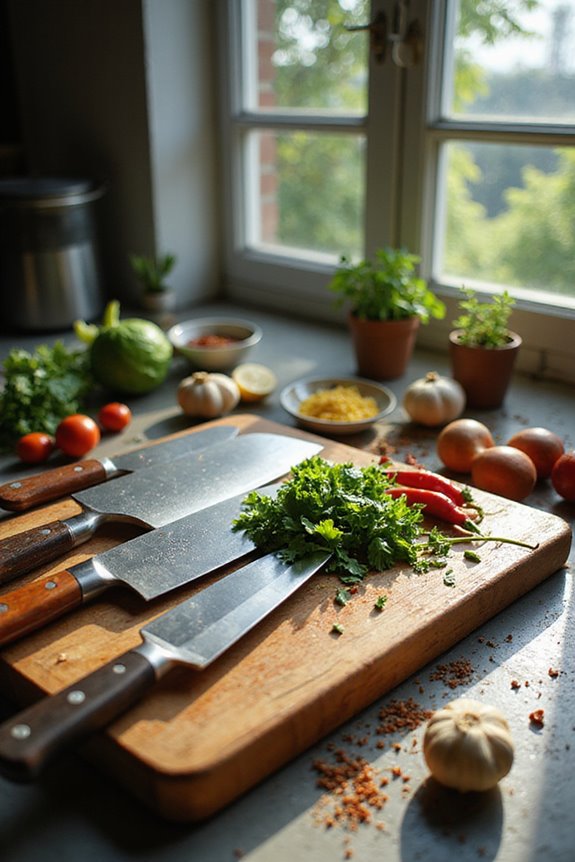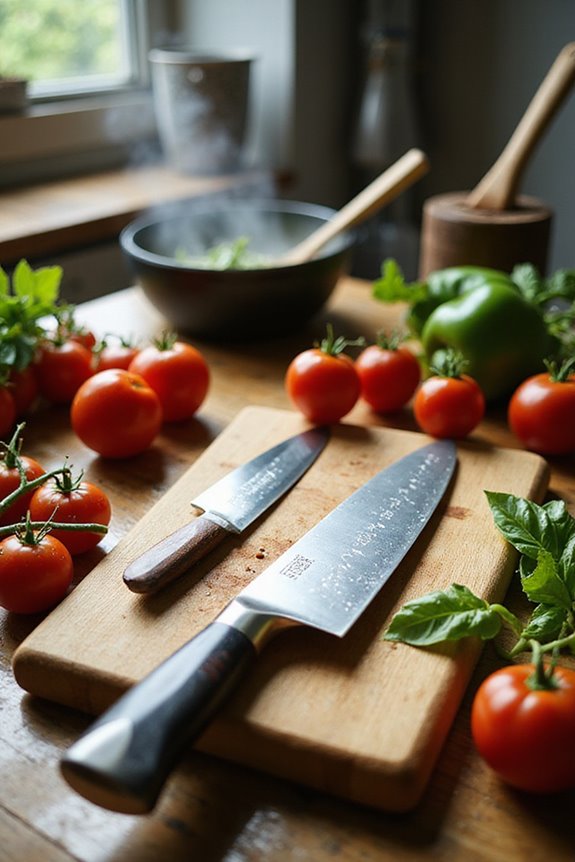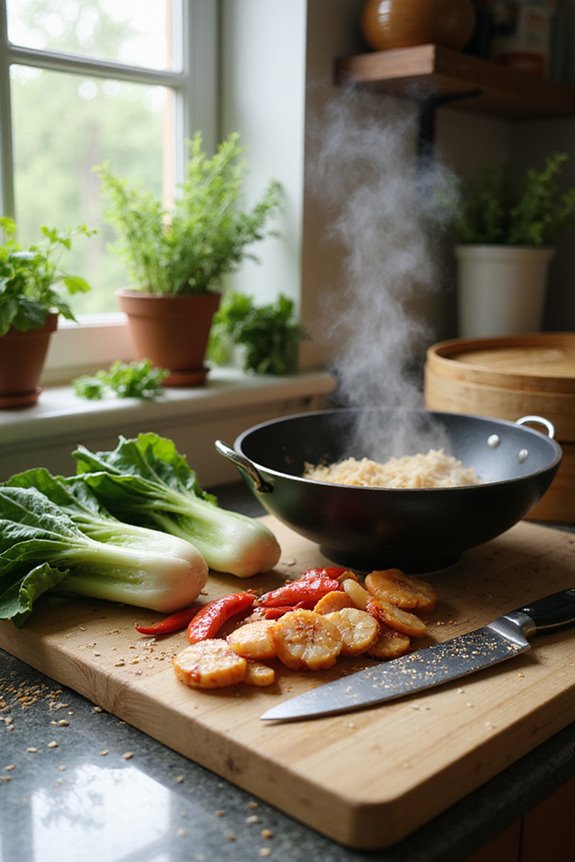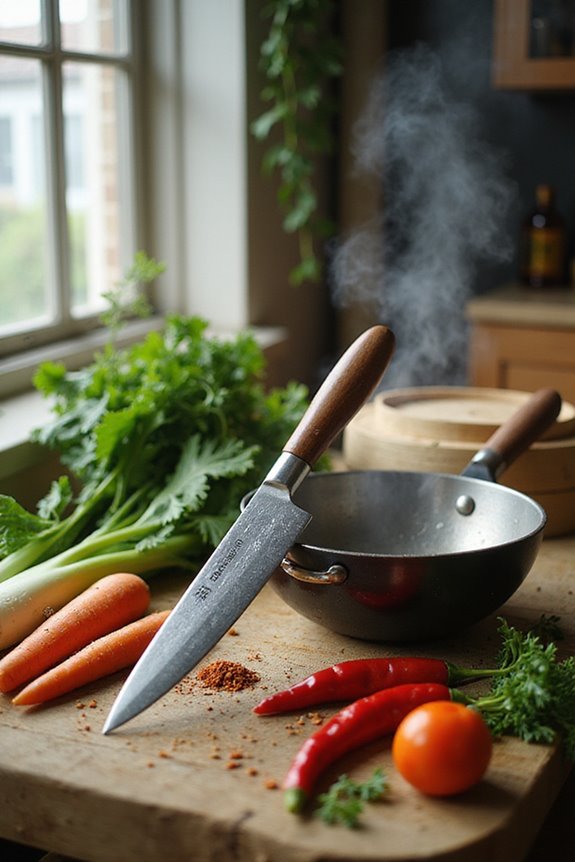As an Amazon Associate, we earn from qualifying purchases. Some links may be affiliate links at no extra cost to you. Although our opinions are based on curated research, we haven't used these products. Articles generated with AI.
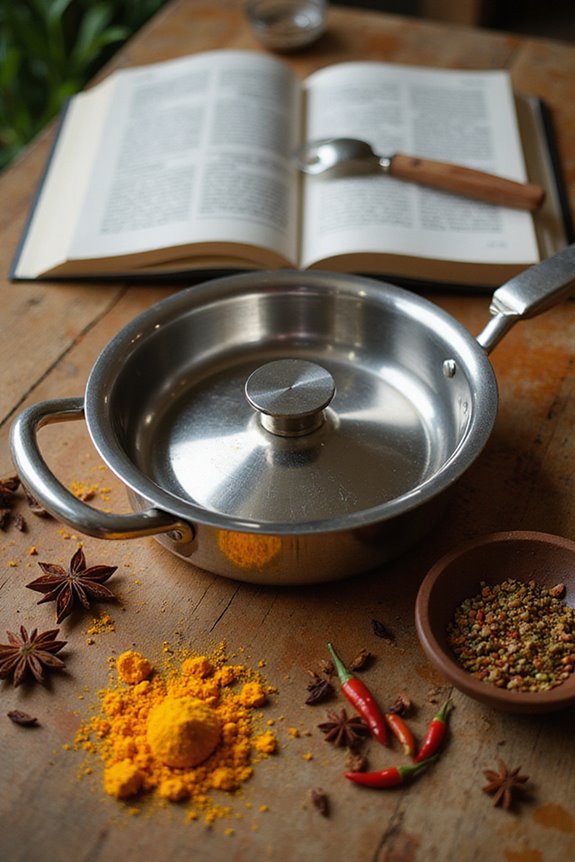
10 Best Indonesian Cookbooks: Your Ultimate Spice Guide for Flavorful Dishes
Discover the rich flavors of Indonesian cuisine with the best cookbooks available. “Cradle of Flavor” and “The Food of Indonesia” offer authentic recipes and cultural insights. For a personal touch, check out “Coconut & Sambal.” Each book features unique ingredients and cooking techniques that help you create delicious dishes at home. Whether you’re a beginner or an experienced cook, you’ll find something to enhance your cooking repertoire. Keep exploring to uncover more delicious recommendations and tips.
Key Takeaways
- Explore authentic recipes from various Indonesian regions like Bali and Java, showcasing unique flavors and ingredients for diverse palates.
- Discover cookbooks with personal stories and cultural insights that enrich the cooking experience and deepen connections to Indonesian traditions.
- Choose visually appealing cookbooks with high-quality images to enhance the cooking process and inspire culinary creativity.
- Look for detailed glossaries to help source hard-to-find ingredients, ensuring a successful replication of Indonesian flavors.
- Consider the variety of cooking techniques presented, from slow cooking to stir-frying, catering to different skill levels and preferences.
Thai Food
If you’re serious about mastering authentic Thai cuisine, the extensive Thai cookbook discussed here is an ideal choice for you. Spanning nearly 700 pages, it serves as a thorough exploration of Thai cooking, authored by a renowned Australian chef with a successful London restaurant. The book’s depth emphasizes authenticity, guiding you through traditional recipes without shortcuts. You’ll appreciate insights into cooking techniques, particularly rice cultivation, revealed through the author’s mentorship under seasoned Thai cooks. While the dishes can be complex, tackling these authentic recipes will enhance your culinary repertoire and deepen your understanding of Thailand’s rich cultural backdrop.
Best For: Serious cooks who are committed to mastering authentic Thai cuisine through traditional recipes and techniques.
Pros:
- Extensive coverage of Thai cooking techniques and cultural context, making it a comprehensive resource.
- Authentic recipes that provide depth and true flavor, reflecting the traditional practices of Thai cuisine.
- Rich educational content that enhances understanding of Thailand’s culinary history and nuances.
Cons:
- Complex and time-consuming recipes that may not be suitable for casual cooks or those cooking for one.
- Limited visual content despite superb photographs, which some readers may desire for better guidance.
- High level of effort required to prepare many dishes, which could discourage less experienced cooks.
Cradle of Flavor: Home Cooking from the Spice Islands
Sale
Cradle of Flavor: Home Cooking from the Spice Islands of Indonesia, Singapore, and Malaysia
- Hardcover Book
- Oseland, James (Author)
- English (Publication Language)
*Cradle of Flavor: Home Cooking from the Spice Islands* is an excellent choice for home cooks keen to plunge into the vibrant world of Indonesian cuisine. This book, authored by culinary expert James Oseland, showcases the richness of Indo-Malay recipes, bridging the gap for those far from home. You’ll discover classics like Beef Rendang and Malaccan Beef Stew, detailed with practical cooking techniques. Oseland’s personal stories and ingredient glossary enhance your cooking experience. Although the book lacks some color photos, the robust recipes and clear guidance make it an essential resource for anyone eager to explore the Spice Islands’ culinary delights.
Best For: Home cooks and food enthusiasts looking to explore authentic Indonesian cuisine and reconnect with the flavors of the Spice Islands.
Pros:
- Offers a rich collection of authentic Indo-Malay recipes, including classics like Beef Rendang and Malaccan Beef Stew.
- Includes personal anecdotes and a detailed glossary that aids in sourcing unique ingredients.
- Commended for preserving traditional recipes while providing practical cooking techniques.
Cons:
- Lacks a variety of color photographs that might enhance the visual appeal.
- May not cater to those unfamiliar with Southeast Asian cooking or sourcing ingredients.
- Some readers might find the complexity of certain recipes challenging for beginner cooks.
The Food of Indonesia: Delicious Recipes from Bali, Java and the Spice Islands
Sale
The Food of Indonesia: Delicious Recipes from Bali, Java and the Spice Islands [Indonesian Cookbook,...
- Holzen, Heinz Von (Author)
- English (Publication Language)
- 112 Pages - 02/10/2015 (Publication Date) - Tuttle Publishing (Publisher)
Looking to plunge into the vibrant flavors of Indonesian cuisine? “The Food of Indonesia: Delicious Recipes from Bali, Java, and the Spice Islands” is an excellent choice for anyone enthusiastic to explore this rich culinary tradition, whether you’re a seasoned cook or just starting out. This book features 79 enticing recipes that showcase authentic dishes from these diverse regions. You’ll appreciate the visually appealing layout filled with clear, enticing images, and straightforward instructions. The ingredients are easy to find, often available at local Asian grocery stores, making your culinary adventures enjoyable and accessible, even if you’re new to Indonesian cooking!
Best For: Anyone interested in exploring Indonesian cuisine, from beginners to seasoned cooks looking to dive into authentic recipes.
Pros:
- Visually appealing layout with clear images and straightforward instructions makes cooking enjoyable.
- Authentic recipes that reflect the diverse culinary landscape of Indonesia, evoking traditional flavors.
- Easily sourced ingredients often available at local Asian grocery stores, enhancing accessibility for all cooks.
Cons:
- Some readers may find the language barrier challenging, as the book is in English.
- A few recipes may require moderate cooking skills, which might be daunting for complete beginners.
- Limited variety in terms of recipes from regions beyond Bali, Java, and the Spice Islands.
Coconut & Sambal: Recipes from my Indonesian Kitchen
Sale
Coconut & Sambal: Recipes from my Indonesian Kitchen
- Hardcover Book
- Lee, Lara (Author)
- English (Publication Language)
Coconut & Sambal: Recipes from my Indonesian Kitchen stands out as an excellent choice for home cooks enthusiastic to explore authentic Indonesian flavors while forging a deeper connection to the culture. This cookbook offers genuine recipes that reflect the author’s heritage, blending simplicity with quality. Users appreciate the ease of following the instructions, often surprising themselves as they master new dishes. While you’ll find fewer photos compared to other cookbooks, the attractive layout inspires experimentation in your kitchen. Be prepared to seek out specific ingredients for accuracy, making each meal a rewarding culinary adventure that deepens your appreciation for Indonesian cuisine.
Best For: Home cooks looking to explore authentic Indonesian flavors and deepen their cultural connection through cooking.
Pros:
- Offers easy-to-follow, authentic recipes that yield delicious results.
- Enhances users’ cooking skills and confidence in the kitchen.
- Attractive layout and presentation inspire culinary experimentation.
Cons:
- Limited number of photos for many recipes may leave some users wanting more visual guidance.
- Some ingredients may not be easily accessible at typical grocery stores.
- Requires specialized cooking tools, such as scales, for accurate measurements.
Easy Thai Cookbook: Step-by-step Guide to Thai Food at Home
Easy Thai Cookbook: The Step-by-step Guide to Deliciously Easy Thai Food at Home
- Used Book in Good Condition
- Morris, Sallie (Author)
- English (Publication Language)
For anyone enthusiastic to plunge into the vibrant world of Thai cuisine, the “Easy Thai Cookbook” by Sallie Morris serves as an excellent entry point. This free NetGalley ebook offers step-by-step guidance perfect for both beginners and seasoned enthusiasts. With clear introductions to essential ingredients and cooking techniques, you won’t feel lost. Explore diverse recipe categories, covering everything from snacks like Prawn Toasts to comforting curries such as Thai Mussaman. Each recipe features approachable instructions paired with mouthwatering visuals. The book even includes helpful meal planning tips, ensuring you create authentic Thai flavors comfortably at home while impressing your guests.
Best For: Beginners and enthusiasts looking to explore authentic Thai cuisine with easy-to-follow recipes.
Pros:
- Comprehensive: Covers essential ingredients, cooking methods, and offers a wide variety of recipes.
- User-friendly: Step-by-step instructions make it approachable for novice cooks.
- Visual appeal: Beautiful photography enhances the cooking experience and inspires creativity.
Cons:
- Limited advanced techniques: May not cater to experienced chefs seeking intricate or advanced dishes.
- Free ebook format: Availability may be limited to those who use NetGalley.
- Potential ingredient accessibility: Some specialized ingredients may not be readily available in all regions.
Kulinarya, A Guidebook to Philippine Cuisine
Kulinarya, A Guidebook to Philippine Cuisine
- Barretto et al., Glenda R. (Author)
- English (Publication Language)
- 240 Pages - 08/30/2016 (Publication Date) - Tuttle Publishing (Publisher)
If you’re enthusiastic to explore the diverse flavors of Filipino cuisine, “Kulinarya, A Guidebook to Philippine Cuisine” is your go-to resource. This guide is perfect for both novice and experienced cooks, offering easy-to-follow recipes that greatly improve your cooking skills. The book features a visually appealing design with high-quality photography that makes each dish tempting. Alongside recipes, you’ll gain valuable insights into Philippine dining culture, enriching your understanding of this culinary tradition. While some critiques exist about recipe presentation and chef representation, the overall quality and informative nature of “Kulinarya” make it a celebrated addition to any kitchen library.
Best For: Enthusiasts of Filipino cuisine looking for a comprehensive resource to enhance their cooking skills and knowledge.
Pros:
- Easy-to-follow recipes suitable for both novice and experienced cooks.
- High-quality photography and well-designed layout enhance the visual appeal of the book.
- Provides valuable insights into Philippine dining culture, enriching readers’ understanding of culinary traditions.
Cons:
- Some readers express dissatisfaction with the presentation of certain recipes.
- Critiques mention that the collaboration of chefs involved may not fully represent authentic Philippine cuisine.
- Mixed reviews may lead to uncertainty for potential buyers regarding the overall quality.
POK POK The Drinking Food of Thailand: A Cookbook
POK POK The Drinking Food of Thailand: A Cookbook
- Amazon Kindle Edition
- Ricker, Andy (Author)
- English (Publication Language)
“POK POK The Drinking Food of Thailand” is the perfect choice for adventurous food lovers keen to explore authentic Thai cuisine. This cookbook by Andy Ricker focuses on recipes perfect for casual drinking snacks and creative hangover solutions. You’ll uncover unique dishes like Thua Thawt Samun Phrai and Yam Plaa Meuk, showcasing genuine flavors. While some ingredients may be tricky to find, Ricker suggests useful substitutes. Keep in mind that a granite mortar and pestle will enhance your cooking experience. This book is best suited for those familiar with Thai food, expanding your culinary skills while indulging in vibrant flavors.
Best For: This cookbook is best for adventurous food lovers and those familiar with Thai cuisine who want to explore authentic drinking snacks and hangover recipes.
Pros:
- Unique Recipes: Features authentic Thai dishes not commonly found in other cookbooks.
- Accessible Instructions: Offers detailed instructions and measurements that make cooking easier.
- Substitutions Provided: Suggests useful substitutions for hard-to-find ingredients, making it user-friendly.
Cons:
- Ingredient Accessibility: Some ingredients may be difficult to procure in the U.S., requiring a well-stocked Asian market.
- Complexity of Recipes: Certain recipes can be complex and may deter beginners without prior experience.
- Specific Cooking Equipment Needed: Approximately 30% of recipes may require specialized cooking equipment like a grill or deep fryer.
Lemongrass and Ginger Cookbook: Vibrant Asian Recipes
Sale
Lemongrass and Ginger Cookbook: Vibrant Asian Recipes
- Hardcover Book
- Tan, Leemei (Author)
- English (Publication Language)
The “Lemongrass and Ginger Cookbook: Vibrant Asian Recipes” stands out as the ideal choice for home cooks enthusiastic to explore authentic Asian flavors without the hassle of Western adaptations. Written by Leemei Tan, this cookbook showcases a diverse range of Asian dishes from Thailand to Indonesia, maintaining genuine authenticity. With practical and accessible recipes, you’ll find ingredients that are easy to source at local Asian markets. The vibrant visuals and user-friendly layout enhance your cooking experience, while Tan’s warm anecdotes make the recipes relatable. Even if you seek more Indian options, the overall quality makes this cookbook a must-have on your kitchen shelf.
Best For: Home cooks looking to explore authentic Asian cuisine with accessible recipes and vibrant flavors.
Pros:
- Authentic representation of diverse Asian recipes from various regions without Western adaptations.
- Practical and accessible recipes using readily available ingredients from Asian markets.
- Visually appealing presentation with high-quality photographs and a user-friendly layout.
Cons:
- Some readers desire additional recipes, particularly in the Indian section.
- Limited focus on Western adaptations may not appeal to all cooks.
- May require some knowledge of Asian cooking techniques for complete beginners.
Fire Islands: Recipes from Indonesia
Fire Islands: Recipes from Indonesia
- Hardcover Book
- Ford, Eleanor (Author)
- English (Publication Language)
Looking to plunge into the vibrant world of Indonesian cuisine? “Fire Islands: Recipes from Indonesia” is an exceptional choice, especially for home cooks enthusiastic to explore authentic recipes. This beautifully designed book boasts authentic dishes like laksa and nasi goreng, with easy-to-follow instructions that cater to cooks of all skill levels. You’ll appreciate its engaging storytelling, striking photography, and insights into Indonesia’s rich culinary culture. Families will find joy in preparing meals together, even utilizing leftovers creatively. With diverse recipes and unique ingredients like bumbu spices, you’re in for an exciting cooking adventure that will elevate your kitchen experience.
Best For: Home cooks and food enthusiasts eager to explore authentic Indonesian cuisine with accessible recipes and cultural insights.
Pros:
- Authentic Recipes: Features a variety of traditional Indonesian dishes, ensuring an authentic cooking experience.
- Engaging Presentation: Stunning photography and storytelling enrich the culinary journey and bring Indonesian culture to life.
- Family-Friendly: Recipes are easy to follow, making it fun for families to cook together and utilize leftovers creatively.
Cons:
- Ingredient Availability: Some unique ingredients may be hard to find in certain areas, requiring substitutions or special orders.
- Skill Level Variability: While many recipes are easy to follow, some may be challenging for complete beginners.
- Limited Dietary Options: Focus may be less accommodating for specific dietary restrictions or preferences outside traditional Indonesian cuisine.
Bangkok: Recipes and Stories from the Heart of Thailand [A Cookbook]
Sale
Bangkok: Recipes and Stories from the Heart of Thailand [A Cookbook]
- Hardcover Book
- Punyaratabandhu, Leela (Author)
- English (Publication Language)
For anyone interested in exploring authentic Thai cuisine, “Bangkok: Recipes and Stories from the Heart of Thailand” stands out as an essential cookbook. Authored by Leela Punyaratabandhu, the book weaves beautiful prose with fascinating stories, making it a joy to read. Although some recipes require a lengthy list of ingredients, including exotic spices, those near Asian grocery stores can easily engage. The vivid photographs and thoughtful layout enhance the experience, while detailed instructions help you tackle dishes like Black Pepper Roasted Chicken. You’ll not only cook but also connect with Thai culture, enriching your culinary journey.
Best For: Anyone passionate about authentic Thai cooking and eager to connect with Thai culture through food and storytelling.
Pros:
- Beautiful writing and engaging stories that make the cookbook enjoyable to read like a novel.
- Visually stunning photographs and thoughtful layout enhance the overall cooking experience.
- Detailed instructions help demystify complex recipes, encouraging cooks to try new dishes successfully.
Cons:
- Recipes often require a long list of specific ingredients, which may be challenging to source for casual cooks.
- Some recipes may be too advanced for beginners or those unfamiliar with Thai cuisine.
- Substitution suggestions are lacking, which could limit accessibility for some cooks.
Factors to Consider When Choosing an Indonesian Cookbook Spice Guide
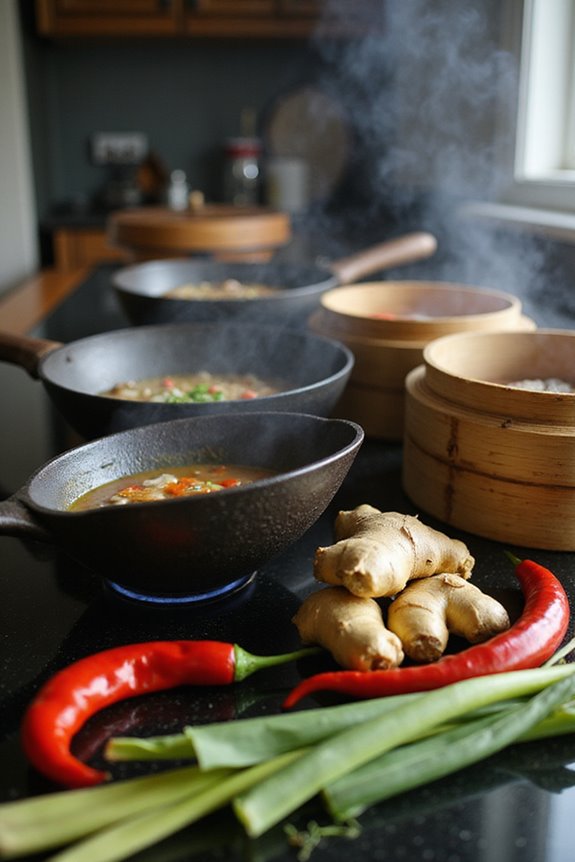
When you’re selecting an Indonesian cookbook spice guide, think about the authenticity of ingredients and if they’re easily found in your local markets. You’ll want a good variety of recipes that cater to different tastes and skill levels. Additionally, consider if the book offers cultural insights and detailed cooking techniques to enhance your culinary journey.
Authenticity of Ingredients
Choosing an Indonesian cookbook that emphasizes the authenticity of ingredients is crucial for anyone wanting to replicate the rich flavors of this diverse cuisine. Authentic cookbooks prioritize traditional staples like candlenuts, galangal, and ketjap manis. These ingredients create the depth and complexity that truly defines Indonesian dishes. Look for books that include detailed glossaries to help you source these unique items, enhancing your connection to the culture. Each ingredient holds historical and cultural significance, such as sambal and coconut, which are essential for achieving traditional flavors. Additionally, authentic recipes often reflect Indonesia’s diverse culinary landscape, requiring specific spices not commonly found in Western cooking. An emphasis on authenticity guarantees your culinary efforts stay true to Indonesian traditions.
Availability in Markets
Understanding the availability of ingredients is essential for your Indonesian cooking journey. When selecting a cookbook, check if it includes a glossary or index of spices, like candlenuts and galangal, that are often hard to find. Opt for books offering shopping tips or specifying where to source these unique ingredients, as some may only be found in local Asian markets. Assess the accessibility of listed ingredients, as many cookbooks aim to utilize items from regular grocery stores or specialty shops in the U.S. Additionally, verify the recipes don’t require uncommon tools or techniques that complicate sourcing. Finally, evaluate the clarity of guidance provided about ingredient sourcing, which directly impacts the authenticity of your Indonesian dishes.
Variety of Recipes
A variety of recipes can transform your Indonesian cooking experience, offering insights into the country’s diverse culinary landscape. When choosing a cookbook, verify it features an array of dishes from different regions like Bali, Java, and the Spice Islands. Opt for books that introduce various cooking methods, such as frying, steaming, and slow-cooking, to enrich your skills. Include a mix of classic recipes and modern interpretations to keep your cooking exciting. Look for cookbooks that categorize recipes into sections like appetizers, main courses, and desserts for easier navigation. Finally, select books that emphasize unique ingredients and techniques, allowing you to fully grasp Indonesian flavor profiles and preparation methods essential for authentic dishes.
Cultural Insights Provided
When exploring Indonesian cookbooks, it’s important to contemplate the cultural insights they offer alongside the recipes. Many authors investigate diverse culinary traditions from Indonesia’s thousands of islands. You’ll discover regional specialties and unique cooking techniques that define each area. Personal anecdotes and historical context may enrich your understanding of how the cuisine has evolved over time. Expect detailed descriptions of traditional ingredients like bumbu spices and galangal, highlighting their significance in cooking. You’ll also encounter explanations of dining customs and food rituals, revealing the social importance of meals in Indonesian culture. Educational sections about sourcing ingredients and authentic practices connect you with the heart of Indonesian culinary artistry, enhancing your appreciation and enjoyment of these flavorful dishes.
Cooking Techniques Explained
Cooking techniques in Indonesian cuisine are crucial to mastering the rich flavors and textures of dishes. Emphasizing fresh ingredients, methods like grilling, frying, and slow cooking deepen flavors. Unique techniques, such as “backward braising,” involve slow-cooking meats in spices before frying, akin to rendang preparation. You’ll want to familiarize yourself with the mortar and pestle, a staple for crafting authentic pastes and sauces from chilies, garlic, and spices. Steaming is also popular, particularly for dumplings and fish, helping to retain moisture and flavor. When you stir-fry or sauté vegetables, these methods quickly cook while maintaining vibrant colors and nutrients, making your meals both nourishing and visually appealing. These techniques are crucial for creating authentic Indonesian dishes in your kitchen.
Visual Presentation Quality
Choosing an Indonesian cookbook isn’t just about the recipes; it’s also about how effectively the visuals communicate the essence of the cuisine. High-quality images can enhance your cooking experience by showcasing dishes vividly, inspiring you to try new recipes. Look for attractive photographs that illustrate cooking techniques and ingredient details, as this can help you prepare each dish accurately. A well-designed layout with clear visual instructions makes recipes more accessible, especially if you’re a novice cook who relies on visual cues. Colorful images evoke the vibrant cultural essence of Indonesian cuisine, connecting you to its rich heritage. Ultimately, the visual presentation quality plays a significant role in your enjoyment and satisfaction with the cookbook, influencing your overall cooking journey.
Frequently Asked Questions
What Are the Essential Spices for Indonesian Cooking?
To master Indonesian cooking, you’ll want to stock up on essential spices. Start with turmeric for its vibrant color and health benefits. Add coriander for a citrusy undertone, and don’t forget cumin which adds earthiness. Chili powder brings heat, while lemongrass offers a fresh, herbal flavor. Finally, include garlic and shallots for depth. Combining these spices will elevate your dishes, creating that authentic Indonesian taste everyone loves.
Are There Vegetarian Options in Indonesian Cookbooks?
Yes, you’ll find plenty of vegetarian options in Indonesian cookbooks. Many traditional dishes are plant-based or can be easily adapted. For instance, recipes often include tofu, tempeh, and a variety of vegetables, allowing you to enjoy authentic flavors without meat. Look for cookbooks that specifically highlight vegetarian or vegan recipes. They’ll guide you through using spices and herbs to create delicious, satisfying meals that showcase the rich culinary diversity of Indonesia.
How Do I Adjust Spice Levels in Recipes?
To adjust spice levels in recipes, start slowly. Add a small amount of the spice, then taste. If it’s not spicy enough, increase gradually. For extra heat, consider adding fresh chilies or chili paste. Conversely, if the dish is too spicy, balance it with sweetness, like sugar or honey, or add dairy products such as yogurt. Remember, it’s easier to add spice than to remove it, so proceed with caution!
Can I Substitute Ingredients for Specific Indonesian Dishes?
When it comes to cooking, sometimes you have to roll with the punches. Yes, you can substitute ingredients in Indonesian dishes, but consider the flavors carefully. For instance, if you can’t find galangal, ginger works as a backup. Similarly, you might swap palm sugar with brown sugar, though the taste will slightly differ. Just remember, substitutions can change the dish’s authenticity, so keep a balanced approach for the best results.
What Tools Do I Need for Indonesian Cooking?
For Indonesian cooking, you’ll need a few essential tools. Start with a mortar and pestle for grinding spices and making pastes. A sharp knife is vital for chopping herbs and meats. Use a bamboo steamer or a rice cooker for perfect rice. Don’t forget a wok or deep frying pan for stir-frying and frying dishes. Ultimately, investing in a good cutting board will make food prep easier and more efficient.










![Bangkok: Recipes and Stories from the Heart of Thailand [A Cookbook]](https://m.media-amazon.com/images/I/516r1AKFqBL.jpg)
